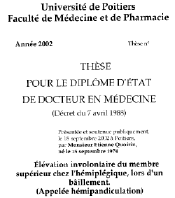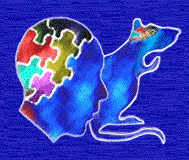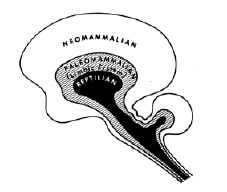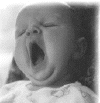mardi 1er octobre 2002 La lettre d'information du site baillement.com N°12 Si vous ne voyez pas les images, cliquez ici pour lire cette lettre dans votre navigateur. If you cannot see pictures below, to view the email in your web browser click here baillement.com est libre d'accès, base documentaire pour comprendre, chercher, travailler

- L'évènement : au cours du XX° siècle, seulement trois thèses de doctorat en médecine parlant du bâillement ont été soutenues en France. Voici la première du XXI° siècle. Etienne Quoirin a soutenu à Poitiers le mercredi 18 septembre 2002, sous la présidence des professeurs Gil et Neau : élévation involontaire du membre supérieur chez l'hémiplégique lors d'un bâillement, appelée hémipandiculation.
- Il a recueilli trois observations originales , complètées de trois autres plus anciennes du service.
- Chacune témoigne d'une lésion ischémique de la capsule interne, coupant le faisceau cortico-nucléaire, et donc la motricité volontaire. Parmi les différentes explications proposées , celle de structures sous-corticales non inhibées reprennant une autonomie est décrite, évoquant un mécanisme comparable à celui dela myoclonie du voile du palais . La phylogénèse montre que respiration et coordination des membres sont liées. Le cheval a un cycle respiratoire par foulée, quelque soit sa vitesse. La station debout, permettant l'usage des membres supérieurs pour d'autres activités que la marche, a fait disparaitre cette coordination obligatoire. Le mouvement respiratoire du bâillement déclencherait le mouvement du bras par une réactivation de cet automatisme associant thalamus et cervelet, non inhibé par le lobe frontal, exclus par la lésion détruisant les voies cortico-nucléaires. Télécharger la thèse. Retrouver sur le site d'autres publications sur cette pathologie :
- Nouvelle observation de bâillement convulsif périodique Liecey Le Courrier Médical 1879
- Associated movements in hemiplegia : their origin and physiological significance Thomson HC Brain 1903; vol 26; p 515-523
- Is yawning a brainstem phenomenon ? Wimalaratana HS, Capildeo R a stroke patient who stretched his hemiplegic arm during yawning Lancet, 6/2/1988, 1(8580), 300
- Assoctiated reactions in the hemiplegic arm Graham Mulley Scand J Rehab Med 1982 14,117-120
- A single report of an hemiplegic arm stretching related to yawning Blin O, Rasol O, Azulay JP, Serratrice G Journal of neurological sciences 126(1994) 225-227
- Involuntary
stretching during yawning in patients with pyramidal
tract lesions: further evidence for the existence of an
independent emotional motor system R. Topper
How do you feel ? Interoception: the sense of the physiological condition of the body AD Craig

- L'identification d'une architecture neuronale spécifique dédiée à la représentation de l'état fonctionnel interne de l'organisme et à son homéostasie permet de comprendre comment les sensations internes influencent le comportement et inter-réagissent avec les émotions. Cet article propose une vision possible de la perception du bien-être ressenti par le bâillement et de la neurophysiologie de sa contagiosité.
- The 'somatic marker' hypothesis of consciousness
- On the basis of neurological analyses of patients
with forebrain lesions, Antonio Damasio has advanced the
'somatic marker' hypothesis of consciousness.He proposes
that the subjective process of feeling emotions requires
the participation of brain regions that are involved in
the mapping and/or regulation of our continuously
changing internal states, that is, in homeostasis. These
feelings help to guide behavioural decisions that affect
survival and quality of life by producing a 'perceptual
landscape' that represents the emotional significance of
a particular stimulus that is being experienced, or of a
projected future action by means of a further 'as-if-body
loop'mechanism. The feelings are grounded in the body
itself, based on multi-tiered and evolutionarily
developed neural mechanisms that control the body's
state. These feelings distinguish between inner-world
representations and outer-world representations, and
allow the brain to build a meta-representational model of
the relationship between outer and inner entities. So,
the representational image of the body's state provides a
neural basis for distinguishing self from non-self, and
re-representations of this image enable the behavioural
neural agent to project the effects of possible actions
onto the state of the body, as well as the resultant
changes in such feeling states due to interactions with
other (external) agents. This hypothesis posits that
degrees of conscious awareness are related to successive
upgrades in the self-representational maps. The
anatomical features of Damasio's hypothesis include a
central role for the anterior insular cortex in the
representation of such feeling states.

Samarthji Lal de Montréal a eu l'amabilité de me communiquer ses travaux sur le bâillement :
- -Lal S, Tesfaye Y, Thavundayil X, Skorzewewska A, Schwartz G Effect of time-of-day on yawning response to apomorphine in normal subjects Neuropsychobiology 2000; 41(4): 178-180
- -Lal S, Grassino A, Thavundayil JX, Bubrovsky B A simple method for study of yawning in man induced by the dopamine receptor agonist, apomorphine. Progr Neuropsychopharmacol Biol Psychiatry 1987; 11; 223-228
- Lal S Apomorphine in the evaluation of dopaminergic function in man Prog Neuropsychopharmacol Biol Psychiatry 1988; 12(2-3): 117-64
- -Lal S, Y Tesfaye et al Apomorphine: clinical studies on erectile impotence and yawning. Prog Neuropsychopharmacol Biol Psychiatry (1989) 13(3-4): 329-39
- -Tesfaye Y, Lal S Hazard of yawning Canadian Med Assoc J 1990;142;1;p15
- -Tesfaye Y, Lal S, Skorzewska A Hazard of yawning Canadian Med Assoc J 1991;145;12;p1560
- -Skorzewska A, Tesfaye
Y , Krishnan B, Schwartz G, Thavundayil J, Lal S
Effect of scopolamine on spontaneous yawning in men.
Neuropsychobiology 1993;27(1):17-20

- Paul Mac Lean, neuropsychiatre américain a beaucoup publié de 1950 à 1985 et a proposé une vue phylogénétique originale du système nerveux ( Les 3 cerveaux : 1961 et ult).
- Selon lui, le cerveau s'est développé par "couches successives", répondant ainsi progressivement aux besoins de l'évolution : d'abord de purs instincts (cerveau reptilien) qui ne possède pas de mémoire, puis acquisition de réponses émotionnelles contrôlées (système limbique) et donc de mémoire; enfin développement très complexe du cortex cérébral (néo-cortex). Ces trois cerveaux cohabitent toujours en nous. Un fonctionnement harmonieux des différents cerveaux est nécessaire en incluant des émotions ou certaines formes de comportement archaïques pour le profit / contôle du néo-cortex siège de la raison / pensée consciente.
- Cette interprètation se prête à merveille à une explication des différents type de bâillements : une nouvelle page du site à visiter
- The American neurologist Paul MacLean is a proponent of "microgenesis", the view that the structure of our brain mirrors its evolution over the ages. Mac Lean believes that our head contains not one but three brains: a "triune" brain. Like the layers of an archeological site, each brain corresponds to a different stage of evolution. Each brain is connected to the other two, but each operates indivually with a distinct "personality". It is a realistic vue for the interpretation of what is yawning.
Données nouvelles
mises à jour du site
- Quatre chapitres du site ont été réécrits ou réillustrés pendant l'été dernier.
- 1 -pourquoi bâillons-nous ? : de nouvelles données liant sommeil paradoxal et bâillement, de nouvelles explications phylogénétiques (neurophysiologie de l'attachement) ont été actualisées.
- 2 -pouquoi le bâillement est-il contagieux ? : l'apport des travaux d'imagerie fonctionnelle cérébrale, en particulier ceux du Prof Decety, enrichit ce chapitre avec possibilité de lire :
- - Neurophysiological mechanisms underlying the understanding and imitation of action Giacomo Rizzolatti and all; Nature Reviews Neuroscience volume 2,;september 2001; p661
- - From the perception of action to the understanding of intention SJ Blakemore, J Decety; Nature Reviews Neuroscience volume 2; august 2001; p561
- 3 - données anatomiques et images de l'embryologie du cerveau
- 4- D'exceptionnelles biographies historiques de neurologuesJean-Martin Charcot et Jules Déjérine, avec la photo du Professeur Déjérine faisant sa visite un matin de 1910, salle Pinel à La Salpêtrière, des photos de A Trousseau par Nadar
Avant-première West Nil virus Encephalitis case report 1 case report 2 N Engl J Med vol 347, n°16, october 17, 2002
- La fièvre West Nile, aussi appelée fièvre de Camargue ou encore maladie à virus du Nil occidental, est une zoonose à symptomatologie grippale, très proche de la dengue, due à l'arbovirus West Nile. Elle est transmissible par des moustiques du genre Culex. Cette maladie peut se compliquer d'un syndrome méningé et parfois d'encéphalite mortelle (1/150). Apparue en 1999, l'extension de cette infection d'Est en Ouest des USA est d'une spectaculaire rapidité. Vous pouvez télécharger dès maintenant et en avant-première trois articles qui paraitront le 17 octobre 2002 dans le New England Journal of Medecine, faisant le point sur cette encéphalite et décrivant de nouvelles variétés de paralysies périphériques, non régressives, rappelant étrangement la poliomyélite. Bien que ce sujet n'ait aucun lien avec le bâillement, j'ai pensé que cette importante information valait de vous en avertir en primeur (un scoop avant TF1!). Cette nouvelle virose a déjà touché des chevaux en Camargue, et des cas humains pourraient se déclarer en France. Voir le site américain de référence CDC West Nile. A noter la dernière publication de l'institut Pasteur annonçant la découverte d'un gêne de susceptibilité au virus de fièvres hémorragiques : Mashimo, T., M. Lucas, et al. (2002). "A nonsense mutation in the gene encoding 2'-5'-oligoadenylate synthetase/L1 isoform is associated with West Nile virus susceptibility in laboratory mice." Proc Natl Acad Sci U S A 99(17): 11311-6.
- The West Nile virus (WNV) is maintained in nature when an arthropod vector transmits the virus between vertibrate hosts. The primary vector for WNV in the United States is the Culex pipiens mosquito that commonly breeds in urban areas and prefers to feed on birds. Mosquitoes acquire WNV when feeding on infected birds. The virus is then stored in the mosquito's salivary glands and transmitted to humans and other incidental hosts when the mosquito takes a blood meal. The virus has been detected in many wild bird species, including the American crow. Humans and other domestic animals are considered "dead-end" hosts, as they do not contribute to the transmission cycle but can develop an illness as a result of infection.
- The WNV has apparently caused six people in
Mississippi and Lousiana to develop polio-like paralysis.
While medical officials have known that WNV can cause
muscle weakness and paralysis in some people, the reports
of a polio-like paralysis represent a broadening of the
concern. Previously, the most common serious complication
from the newly arrived, mosquito-borne disease has been
encephalitis. In most of the paralysis cases, the victims
were previously healthy and middle-aged. The extent of
the paralysis varies widely, with some victims losing the
use of an arm or a leg while several others were forced
to use ventilators to breathe, and none has recovered.
You can find on this website the future publication of
the NEJM about these
cases reports.
Si vous souhaitez élargir vos connaissances en neuroanatomie comparée, une visite s'impose au très original site web the Comparative Mammalian Brain Collections (CMBC) qui recèle une extraordinaire collection de cerveaux d'une large palette de mammifères. Vous y trouverez des données neuroanatomiques englobant l'exotique lamantin et la vache ou le porc. CMBC livre une atlas complet du cerveau de 15 espèces, sous forme de photos ou de films, avec des sections anatomiques sériées. Pas moins de 200 espèces de mammifères dévoilent ainsi leur cerveau, avec pour la plupart, au moins une coupe coronale, montrant la structure interne. En prime, une page originale est dévolue à la "paleoneurologie", soumettant à la réflexion l'image d'empreintes du cerveau dans des boites craniennes d'espèces éteintes, bases d'étude phylogénétique.
If you want to expand your repertoire, you should definitely pay a visit to the Comparative Mammalian Brain Collections (CMBC) web site, which features an extraordinary collection of brains from a broad spectrum of mammalian orders. There you will find neuroanatomical information on species as exotic as the manatee or as ordinary as the cow and the pig. The CMBC site contains complete brain atlases of at least 15 species, which can be displayed as photographs or as movies that allow you to take a quick look through sections of the whole brain.There are also whole-brain photographs from nearly 200 different mammals, most of which are accompanied by at least one coronal section toget a glimpse of the innerstructure of these nervous systems. In addition, there is a page devoted to "paleoneurology" the analysis of brain endocasts from extinct vertebrates, which provides a useful introduction to the study of brain evolution.
De l'évolution et des comportements Evan Balaban Changes in multiple brain regions underlie species differences in a complex, congenita behavior Proc. Natl. Acad. Sci. USA; Vol. 94, pp 2001-2006, March 1997
Les différences cérébrales apportées par l'évolution entre deux espèces proches et à la base de comportements congénitaux divergents n'ont jamais, jusqu'à présent, été élucidées. Cette étude porte sur une association comportementale: chants, hochement de tête et bâillements chez le poulet et la caille. Ce travail rapporte les expérimentations basées sur des transferts d'une espèce à l'autre de greffes cérébrales localisées et les modifications comportementales ainsi induites !The evolutionary brain modifications that produce any complex, congenital behavioral difference between two species have never been identified. This study explores the brain localization of a species difference in one such behavior, the crowing and yawning of chickens and Japanese quail. Two major subcomponents of the behavioral difference can be independently transferred with interspecies transplantation of separate brain regions, despite the fact that these components, sound and patterned head movement, occur together in a highly integrated fashion.
The cognitive neuroscience of sleep: neuronal systems, consciousness and learning J Allan Hobson et EF Pace-Schott Nature Reviews Neuroscience, sept 2002; vol 3; n°9; 679-693.
- J'avais signalé dans la lettre du 1 septembre 2002 l'article : The neurobiology of sleep: genetics cellular physiology and subcortical networks de J Allan Hobson et EF Pace-Schott. Le deuxième partie est parue, traitant de la neurophysiologie de la cognition pendant le sommeil, de l'élaboration du rêve et de la consolidation de la mémoire.
- et en complément d'articles déjà proposés sur le site en anglais (voir la lettre n°9 ):
- Hypocrétine (orexine) et narcolepsie : dormir ou dîner une mise au point de Emmanuel Mignot, en français.
- Télécharger au format PDF : A brief history of hypocretin/orexin and narcolepsy de JM Siegel
-
Publication de septembre 2002 une page complète à découvrir prochainement Bâillements et prématurité 
- Giganti, F., M. J. Hayes, et al. (2002). "Yawning and behavioral states in premature infants."
- Dev Psychobiol 41(3): 289-96.
- Low risk, premature infants between 30 to 35 weeks post-conceptual age (PCA) residing in an neonatal intensive care unit environment were observed in the home incubator for spontaneous yawning from 2400 to 0500 hr. Videorecordings were analyzed for the behavioral states of quiet sleep (QS), active sleep (AS), wake (W), and drowse (D) in 3-min epochs as well as the contextual behaviors before and after yawn events using a 1-min window. Yawning periods predicted higher levels of motoric activation than nonyawn periods. Sequence analysis of preceding and following states with or without yawns were examined for stability or change. All states with or without yawn events had state stability for the preceding and following epochs, with two exceptions: 1) D state with yawning was associated with state change in the preceding 3-min epoch (most often W), and 2) D state without yawning was associated with state change in the following epoch (W or AS). Yawns were not present in QS. The results suggest that yawning is associated with increased behavioral arousal that is not state-specific. However, yawning in D state predicts state transitions in the preceding, but not the following, epoch. It is proposed that D may be an unstable state that becomes more stable when yawning is present.
Ajout d'un moteur de recherche direct dans Biomed-Pubmed à la page de bibliographie
Autres documents mis en ligne ce mois-ci :
- Multifocal sites of action involved in dopaminergic-cholinergic neuronal interactions in yawning Ushijima I
- Le syndrome operculaire unilatéral d'origine vasculaire B.Pertuiset et coll
- Le syndrome operculaire unilatéral d'origine vasculaire G. Boudin et coll
- Syndrome de Foix Chavany Marie d'origine traumatique A Laurent-Vannier
- The opercular syndrome - diagnostic trap in facial paralysis RL Crumley
- Le syndrome operculaire unilatéral avec atteinte controlatérale du territoire des nerfs craniens Alajouanine
- La diplegie faciale cérébrale (forme corticale de la paralysie pseudo-bulbaire) Alajouanine
- Paroxysmal kinesigenic dystonia associated with a medullary lesion Riley DE
- Desipramine induces yawning behaviour in rats Mogilnicka E et all
- L'expression des émotions chez l'homme et les animaux Charles Darwin 1889
- The emergence of fetal behaviour de Vries, Visser, Prechtl
- Effects of stress on drug induced yawning Tufik S et coll
- Treatment with dexamethasone alters yawning behavior induced by cholinergic Hipolide DC
- Influence of different adrenoceptor agonists and antagonists on physostigmine-induced yawning in rats
- Unusual variants of infantile spasms Donat JF, Wright FS
- Migraine postdromes: symptoms after attacks Blau JN
- Transient
cerebral ischemia evoked by yawning Handa J
au 30 septembre 2002
- Nombre de questionnaires remplis : 483
- Combien de fois bâillez-vous par jour ? <5 = 26,1%.. 5-10 = 26,1%.. 10-15 = 14,1%.. 15-20 = 9,7%.. >20 = 24%
- Ressentez-vous des baillements excessifs ?
- 76,6% = non, tant
mieux
24,8% = oui et je ne sais pas pouquoi - 7,2% = oui et je prends des antidépresseurs
- 1,2% = oui et je prends
des anti-épileptiques
5,6% = oui et je prends d'autres médicaments
3,3% = oui et j 'ai des troubles neurologiques
2,3% = oui et j 'ai des troubles hormonaux
3.7% = oui et j 'ai des tics moteurs
2,3% = oui et j 'ai des tocs - déclenchez-vous facilement le bâillement d'autrui ? 72,5%
- êtes-vous sensible au bâillement d'autrui ? 73,3%
- écrits et réalisés par
- le Dr O Walusinski ..
« Le plus grand profit qu'on retire de l'étude et des sciences est celui de se mettre en état de ne s'étonner de rien » Christine de Suède
courriel à adresser lire les lettres précédentes d'information du site


